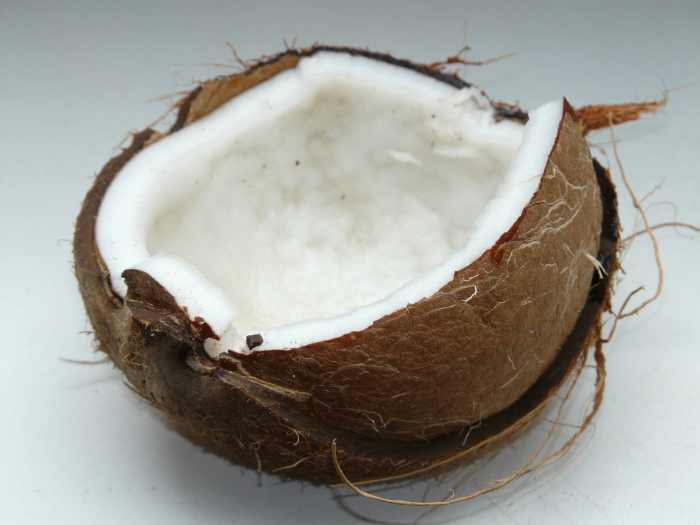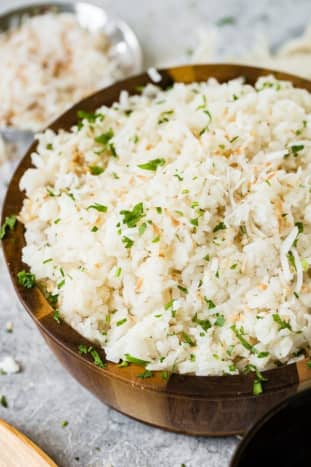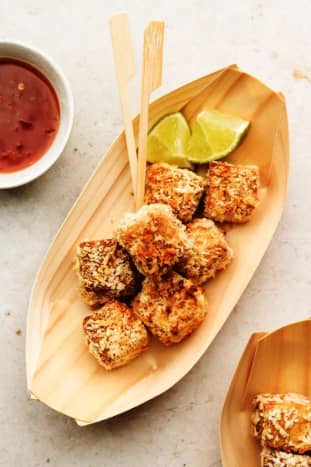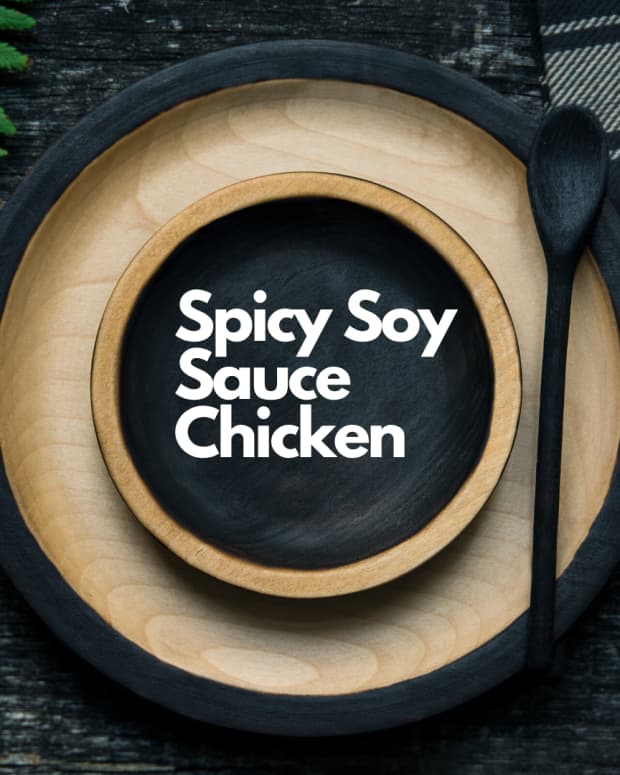Exploring Coconut: Facts, Fables, and Fun Recipes
Linda explores food facts, folklore, and fabulous recipes, one ingredient at a time.
The Tree of Life
For thousands of years the “tree of life,” the coconut palm, has sustained countless inhabitants of every subtropical coastline around the world. It provides food, drink, building materials, and even fuel, thriving in areas of high salinity where other crops would certainly fail.
The coconut played a crucial role in the history of human exploration and dispersal across the tropics, and it continues to play a fundamental role in human societies today. As a portable source of nutrition and water, the coconut was critical for humans to be able to voyage, establish trade routes, and colonize lands in the Pacific Rim, coastal India, Africa, and South America.
— Dr. Kenneth Olson, Washington University
Of all the storied foods on earth, the coconut might be the most complex, confusing, and mysterious. Although there are over 1,000 varieties of the coconut palm, there are only two distinct species. In fact, genetically they are so dissimilar one can only theorize that they evolved in two entirely different places, being domesticated and cultivated numerous times.
The coconut likely rose from one birthplace, but nature and human intervention moved it across oceans to different continents, and that is where we begin.
How Coconut Trees Are Categorized
Non-scientists (lay people like you and me) had categorized coconut trees in two ways, the tall forms and the dwarfs. Five percent of coconuts are the dwarf variety; they mature quickly and are self-pollinating. It had always been assumed that they were domesticated. On the other hand, the tall coconuts were presumed to be wild, the ancestral tree, because they appeared to be unaffected by human selection and were better adapted to a swim across the sea.
“The trouble is it’s messier than that. You almost always find coconuts near human habitations, and “while the niu vai (Asian coconut) is an obvious domestication form, the niu kafa (Pacific coconut) form is also heavily exploited for copra (the dried meat ground and pressed to make oil) and coir (fiber woven into rope).” Dr. Kenneth Olson, Washington University, St. Louis
In 2006 Dr. Kenneth Olsen, a plant evolutionary biologist at Washington University, St. Louis, received a $20,000 grant from the National Geographic Society to study the DNA of the coconut so that the story of its cultivation and dispersal around the world could be better understood.
Dr. Olsen’s study led him to identify a species unique to the Pacific group of islands comprising Brunei, Indonesia, Malaysia, the Philippines, Singapore, and East Timor. This fruit, niu vai, is the round one we think of when we hear the name “coconut.”
In contrast, the Indo-Atlantic coconut, the niu kafa, is oblong, triangular in shape with a thick fibrous husk. Perhaps as early as the time of Christ, Arab traders were transporting coconuts from India to the shores of East Africa. To this day, the Arabic word for coconut is zhawzhat al-hind, “walnut of India.” Portuguese sailors also contributed to the distribution of the fruit in coastal India and Sri Lanka to West Africa, then to the Caribbean and finally east Brazil. All of these migrations have occurred within the last few centuries, in contrast to the spread of the Pacific coconuts which occurred several thousand years ago.
How Did the Pacific Coconut Move to Asia?
Coconuts float. Later in this article, we'll see how a shipwreck planted coconuts on an entirely new shore. But, there was also human intervention in the movement of coconuts. Dr. Olson’s research led to the conclusions that:
- In the Pacific, coconuts were most likely cultivated in the area of Malaysia, Indonesia, and The Philippines. It was in this place that the subset of self-pollinating, dwarf coconuts arose.
- In the Indian Ocean, coconuts were likely cultivated in the southern regions—Sri Lanka, Laccadives, and the Maldives.
Dr. Olson and his colleagues believed that Pacific coconuts had been introduced to Asia by ancient Austronesian trade routes. Dr. Olson’s colleague, Bee Gunn (now at the Australian National University in Australia), collected DNA samples from coconuts in the western Indian Ocean area (Madagascar and the Comoros Islands) and made yet another amazing discovery. In Madagascar and the Comoros Islands there is a third genetic mix—a blend of the Pacific and Asian types. As explained on the website of Washington University-St. Louis:
"Olsen points out that no genetic admixture is found in the more northerly Seychelles (an archipelago located 1,000 miles east of the African coast in the Indian Ocean) , which fall outside the trade route. He adds that a recent study of rice varieties found in Madagascar shows there is a similar mixing of the japonica and indica rice varieties from Southeast Asia and India.
"To add to the historical shiver, the descendants of the people who brought the coconuts and rice are still living in Madagascar. The present-day inhabitants of the Madagascar highlands are descendants of the ancient Austronesians, Olsen says “The scientists were astonished by the amount of structure in the coconut DNA, enough structure to allow them to trace some of the coconuts travels with humans.”
How a Shipwreck Brought Coconuts to Florida
The Providencia was a 175-ton two-masted ship registered under the flag of Spain. On January 9, 1878, it was bound for its homeport of Cadiz, Spain, laden with a cargo of beans, garlic, logs, rum and cigars from Cuba, and 20,000 coconuts from Trinidad. What should have been a routine voyage instead went horribly wrong . . . and fortuitously right, it just depends on one’s point of view.
It was a clear-weather day, but the ship ran aground; the crew had dabbled a bit too much in that Cuban rum. In their alcohol-fueled fog, they believed they had landed in Mexico. That’s the bad news.
The bright side was that those 20,000 coconuts were scattered along the coast and took root. Within a decade the once barren shore was lined with palm trees and the area formerly known as Lake Worth Country opened a post office and named their town Palm City. The residents soon learned, however, that another Palm City existed some 40 miles away, so the post office was renamed Palm Beach. Fifty years later, this report appeared in the Palm Beach Post:
“From that wreck has grown the palms that line the streets and parks of Palm Beaches… Twenty-thousand coconuts provided the beginning of trees not indigenous to the area, but quite at home, nevertheless.” Palm Beach Post, November 20, 1938
And that seems to be the way of the coconut, indigenous to a group of Pacific islands but now finding a home on tropical shores around the globe.
Oven-Fried Coconut Chicken
Oven-fried coconut chicken is both sweet and savory, satisfyingly crisp and crunchy, and, since it's baked in the oven (not deep-fried) it's much healthier than any frozen or fast-food version of fried chicken. And, you can have it ready for your family in less than an hour.
Of course, you could serve this with the "traditional" potato salad or coleslaw, but why not use the coconut influence to take your "fried" chicken meal in a different direction? For example, I've several choices for you for homemade coconut rice.



Coconut Rice Three Ways
1. Pineapple and Coconut Rice
Our first recipe is pineapple and coconut rice—this tropical side dish is reminiscent of the flavors of Hawaii. Jasmine rice simmers in coconut milk; the flavor is light and not too sweet. Chicken broth (or you could use vegetable broth) and soy sauce provide a contrasting salty taste. When the rice is fully cooked, fluffed, and ready to serve stir in crushed pineapple, sesame oil (which adds a rich nutty flavor) and garnish with slivered almonds or macadamia for a crunchy contrast.
2. Brazilian Coconut Rice
Brazilian coconut rice is creamy-sticky, sweetened with brown sugar. The recipe as shown utilizes short-grain rice (hence the stickiness) lightly toasted to add a nutty flavor, but you could substitute brown rice. Carrian and Cade cook their rice in the microwave, in an Instant Pot, or on the stovetop.
3. Jamaican Rice and Pigeon Peas
Our third recipe is Jamaican rice and pigeon peas, a popular side dish in Jamaica. Despite the name, pigeon "peas" are actually a legume (bean). You can find them in any well-stocked grocery store or buy them online. A reasonable substitute would be kidney beans, black-eyed peas, baby limas, or lentils.
Oven-Fried Coconut Shrimp With Sriracha-Orange Dipping Sauce
I love crunchy shrimp but never deep-fry anything. Shrimp baked in the oven cook quickly with no oily mess and instead of grease you actually taste the sweet shrimp meat. The dipping sauce is a tad spicy—if you're feeling shy use less sriracha to start with. You can always add more if you want more heat.
Ingredients
- 1 cup panko bread crumbs
- 1/2 cup unsweetened flaked coconut
- 1 teaspoon salt
- 1/4 teaspoon
- 1/2 cup all-purpose flour (can use gluten-free)
- 1 pound large shrimp, peeled and deveined (leave the tail on)
- 2 eggs, whisked until blended
- Non-stick cooking spray
Instructions
- Preheat oven to 425 degrees F and line a large rimmed baking sheet with parchment paper.
- Combine bread crumbs and coconut in a shallow bowl; combine salt, pepper, and flour in a second shallow bowl.
- Place the beaten eggs in a third shallow bowl.
- One at a time coat the shrimp. Coat first with flour. Shake off any excess flour and coat with the egg. Lastly, coat with the crumb/coconut mixture. Place in a single layer on the parchment-lined pan.
- Lightly spritz the coated shrimp with cooking spray.
- Bake in preheated oven 8 to 10 minutes, or until crisp and golden; don't overbake.
- Serve with dipping sauce.
Dipping Sauce
Stir together
- 1/2 cup mayonnaise
- 1/4 cup unflavored Greek yogurt
- 1/4 cup orange marmalade
- 1/4 cup sriracha (or to taste)
Slow-Cooker Dairy-Free Butter Chicken
Butter chicken is one of the most popular Indian curry dishes. Similar to chicken tikka masala, it's chunks of tender chicken breast simmered in an aromatic sauce of tomatoes and cream. This slow-cooker dairy-free butter chicken is a much lighter version. Heavy cream and butter are replaced with coconut milk and coconut oil.
Island Glazed Chicken and Coconut Rice
This island glazed chicken and coconut rice is dinner in a dish that's both sweet and spicy. White rice simmers in lime juice and coconut milk while chicken breasts or thighs nestle on top. A blend of soy, Sriracha, brown sugar, and garlic are basted on top to make a tangy caramelized glaze with a little bit of a kick. If you don't have pineapple, fresh mango would be a great substitution.



Coconut Tofu Three Ways
I selected these recipes to show how the flavors showcased in the above recipes can be enjoyed by vegetarians and vegans as well.
1. Coconut-Crusted Tofu
The oven-fried coconut chicken and coconut shrimp look amazing, don't they? But what if you're vegetarian or vegan? You can still enjoy that sweet-savory crunchy crust if you follow this recipe for coconut-crusted tofu. These can be oven-baked or prepared in an air fryer. Use them in a buddha bowl with veggies and a whole grain, dip in a sweet chili sauce, or toss with Thai peanut sauce.
2. Vegan Butter Chicken
The recipe I shared for dairy-free butter chicken uses coconut milk in place of heavy cream. That's great if you only need to avoid lactose, but which if you don't want to eat meat? Vegan butter chicken tastes and "feels" like the real thing. This time, extra-firm tofu is torn and baked until golden and crispy (the ragged edges make it more "chicken-like").
3. Orange-Coconut Baked Tofu
Our third tofu recipe is orange coconut baked tofu. It's spicy with garlic and ginger, savory-umami with soy sauce and rice wine vinegar, tart with orange juice, and crunchy with unsweetened coconut.
Coconut (Vegan) Bacon
This recipe might sound very odd but trust me, it's freaky good. With just five ingredients and 20 minutes, you can create a treat that's smoky, salty, crunchy—just like bacon—but it's made with large flakes of coconut. Vegan coconut bacon is gluten-free, egg-free, dairy-free, and did not inflict harm on any piggies.
Coconut Macaroons
Only 5 ingredients are needed to make these cookie-candies.
- Of course, because it's the star of the show your shredded sweetened coconut must be fresh—don't pull out a 6-month old bag from the pantry.
- Sweetened condensed (not evaporated) milk is the glue that holds it all together.
- The vanilla extract gives flavor.
- Egg whites are whipped to soft peaks and folded in for structure and lift.
- And finally, a pinch of salt balances the sweet flavors.
Only one more ingredient might improve Lauren's coconut macaroons; I would dip them in melted dark chocolate.
Trivia
- The name coconut is derived from the word coco which, in Portuguese means goblin or monkey. To many people, those three distinctive markings on the shell look like the face of a monkey.
- The slogan for Mounds ("sometimes you feel like a nut, sometimes you don't"), a U.S. coconut chocolate bar, was created during a contest of which the winner won an amazing $10.
- In 2016 over 59 million tons of coconuts were produced worldwide.
- In one year a coconut palm can produce up to 180 coconuts.
- Mature trees can reach 100 feet in height and yield 75 fruits per year.
- Although they can tolerate some cold weather, the coconut palm prefers full sunlight and copious amounts of rainfall.
- Almost three-fourths of the world coconut harvest comes from Indonesia, India, and the Philippines.
- In Malaysia and Thailand, pig-tailed macaques are trained to harvest coconuts.
- There is an urban legend that more people are killed by falling coconut than by shark attacks.
- The husk of the coconut can be burnt to act as a natural mosquito repellent
Sources
- Coconut Republic
- Coconut Oil Central
- Washington University in St. Louis, The Olsen Lab
- Aramco World
- Scientific American
- The Fact Site
- West Palm Beach
- Palm Beach Post
- Science ABC
© 2021 Linda Lum
Comments
manatita44 from london on February 03, 2021:
A sweet thin to say, Dee. A really sweet thing to say. Glory be!
Linda Lum (author) from Washington State, USA on February 03, 2021:
Thank you Chitrangada for your kind words. I chose to focus on coconut as a food ingredient but I know I could write as much or more about its health benefits. I did not know of the religious aspect; I will look into that. I enjoy learning from my readers.
Chitrangada Sharan from New Delhi, India on February 03, 2021:
Great article about the coconuts. I liked going through the information you have shared here.
We use coconuts almost regularly, not only for the recipes, but it’s also considered auspicious for religious purposes. It has many more health benefits, and good for skin and haircare.
A very well written, well researched and informative article. Thank you for sharing.
Linda Lum (author) from Washington State, USA on February 02, 2021:
Shauna, I'm glad you were able to find this and comment. Your brother is quite the artist. Dare he venture into his backyard without wearing a helmet?
Shauna L Bowling from Central Florida on February 02, 2021:
Oh, looky here! When I looked for this article in my feed earlier, it wasn't there. Now it is!
Linda, my brother, who lives in Palm Beach County, Florida has a coconut palm in his back yard. He had so many fall around Christmas time that he placed them on his back patio in the shape of a Christmas tree. I thought that was so clever. The epitome of Christmas in Florida.
Thanks to your well-written history of the coconut's travels over time, I now know how a tree ended up in his back yard.
Linda Lum (author) from Washington State, USA on February 02, 2021:
Manatita, I've never tasted coconut water, but I'm sure it has many healthy properties.
Linda Lum (author) from Washington State, USA on February 02, 2021:
Flourish, I had fun researching this one.
Linda Lum (author) from Washington State, USA on February 02, 2021:
Audrey, a tough nut to crack for sure. I'm trying to imagine fresh coconuts anytime I want them--is that Heaven?
manatita44 from london on February 02, 2021:
Lovely story. We've done tons of stuff with coconuts in the caribbean. Now I buy the juice in Supermarkets. No substitute.
FlourishAnyway from USA on February 01, 2021:
You have no idea how much I loved this one! There are so many intriguing recipes begging experimentation, and the history (who knew?)!
Audrey Hunt from Idyllwild Ca. on February 01, 2021:
Yeaaaay, I made it here before your article reached Niche Heaven!
What's not to like about coconut? Only one complaint from me. Hawaii was my home for 10 years. I picked these hairy beauties off the ground whenever a recipe called for coconut, or when I had a hankering for fresh coconut right from the shell. My frustration was cracking the shell open. A tough nut to crack for sure.
Great work, Linda. Nice to be able to comment.
Stay safe and be well, wonderful lady!
Linda Lum (author) from Washington State, USA on February 01, 2021:
Denise, I thought perhaps I might be able to tempt you with the "bacon." Thanks so much for stopping by. (Have you noticed that none of us in the circle of friends who published today have had our articles moved to Discover?)
Denise McGill from Fresno CA on February 01, 2021:
I'll have to give that coconut tofu a try. I love coconut macaroons and have a vegan version I usually make. This was very educational. I really enjoyed it!
Blessings,
Denise
Ann Carr from SW England on February 01, 2021:
That's good; glad you're ok.
Ann
Linda Lum (author) from Washington State, USA on February 01, 2021:
Good day Ann (still morning for me supper time for you). I am well but had a restless sleep. Nothing wrong. Thanks for your concern. You are a love.
Thank you also for your kind words. I think I'll do the coconut-crusted chicken sometime this week.
Ann Carr from SW England on February 01, 2021:
I love coconut! Interesting details here, from them floating to being in shipwrecks! Great fun! And your recipes are, as always, wonderful. They all look delicious and it's just as well I'm about to have supper as they've made me hungry.
I read just now (think it was Bill's hub) that you're tired. I hope you are well and that you recoup your energies. Take care.
Ann
Linda Lum (author) from Washington State, USA on February 01, 2021:
Ravi, I learned so very much when researching this topic. I am glad that you approve.
Ravi Rajan from Mumbai on February 01, 2021:
Thanks, Linda. I am from the Kerala state in India and in my state we utilize every part of the coconut tree from the roots to the leaf. The tree is the lifeline and without it, nothing can run
Thanks for this wonderful article about the virtues of this great fruit.
Linda Lum (author) from Washington State, USA on February 01, 2021:
Eric, it was my pleasure. I hope you and Gabe can have fun with this one.
Linda Lum (author) from Washington State, USA on February 01, 2021:
Bill, you have excellent taste (in candy bars and in friends LOL).
Linda Lum (author) from Washington State, USA on February 01, 2021:
Thank you, Dora. I enjoyed putting this one together.
Eric Dierker from Spring Valley, CA. U.S.A. on February 01, 2021:
Wow this was a fun read. I love coconut anything. I like using my drill to get the "water" out first. Perhaps my favorite sweet food is the Macaroon. Stuff made out of the nut and bamboo are fully sustainable and cool.
Thank you for a great article.
Bill Holland from Olympia, WA on February 01, 2021:
My two favorite candy bars....Reese's Peanut Buttercups, and Mounds. Now I mention Mounds because they are coconut and chocolate.
Enough said about coconut. I've even liked the coconut "milk" straight out of the coconut.
See, I'm not hopeless after all. :)
Happy February, my friend. Rest up and feel better soon.
Dora Weithers from The Caribbean on February 01, 2021:
The history of the coconut in informative and interesting. The recipes are all that, plus appealing. Thanks.
Linda Lum (author) from Washington State, USA on February 01, 2021:
Umesh, thank you for stopping by.
Umesh Chandra Bhatt from Kharghar, Navi Mumbai, India on February 01, 2021:
Very informative. Thanks.
Linda Lum (author) from Washington State, USA on February 01, 2021:
Rebecca, it's so easy and I always like making something crispy that doesn't have to be deep fried.
Rebecca Mealey from Northeastern Georgia, USA on February 01, 2021:
Interesting information, and great recipes. Now I can make coconut shrimp at home. Thanks!
Linda Lum (author) from Washington State, USA on February 01, 2021:
Thanks Pamela for your kind words. This one took a bit more work than usual; I'm glad you enjoyed it.
Pamela Oglesby from Sunny Florida on February 01, 2021:
I had no idea that the history of the coconut was so interesting. My husband adores coconut, and I make a good coconut custard dush for him.
I like some of the recipes you shared and I will try the oven fried chicken with coconut. There are a couple of other recipes that look good also. The Vegan bacon is a surprise. I think it would be good to try it too.
Thanks for sharing an excellent article, Linda, that has a wealth of good information. Have a wonderful week!




























